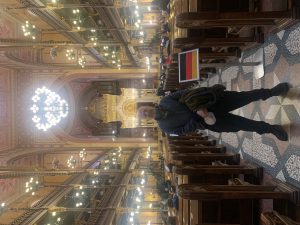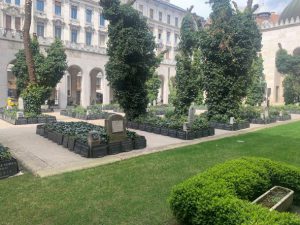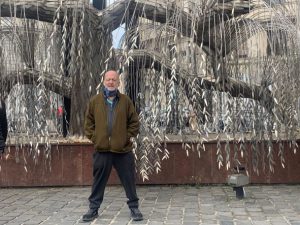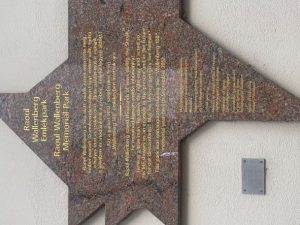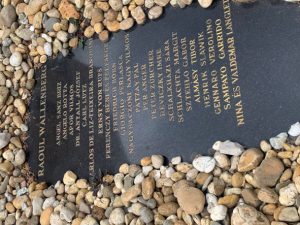May 6, 2022
Research Comes Alive: Stefurov
Last year Lyle Spatz and I published our third book together, COMEBACK PITCHERS: THE REMARKABLE CAREERS OF HOWARD EHMKE AND JACK QUINN. It was recently awarded a 2022 SABR Baseball Research Award. Jack Quinn pitched Major League baseball until the age of 50, a remarkable sign of fitness, endurance, determination, and love of the game.
Some years ago I took part in a remarkable genealogical project that determined that Jack Quinn (who took the Irish name to avoid discrimination as an Eastern European) was born in the village of Stefurov, Austro-Hungarian Empire (now Slovakia) in 1883. The family name was PAJKOS. We had the help of a Slovakian genealogist and were able to find his baptism record, as well as his entry on the manifest of a steamship from Germany with his parents. They left the old country after Johann’s (Jack, or John) three siblings died as infants. They settled in the coal country of NE Pennsylvania.
On my last full day in Slovakia, I took a two-hour train to Stropkov (NE of Kosice), where Martin Pazdic met me, and we headed to Stefurov. The mayor, Jana Riskova, knew we were coming. Every town in SLovakia has a mayor, even Stefurov, population 117. When we walked into her office, her binder had a copy of Jack’s Wikipedia page. We discussed the town’s history, looking old entries in a journal. There was a terrible fire in the town, though we don’t know the date. I learned that the wife of a famous Hungarian, Dessewffy, gave the land in the area to the inhabitants.
I then met the town priest, before walking to the lovely little church (recently restored) with an immense bell above. It overlooks such a peaceful valley. The cemetery surrounds the church. The “empty” field adjacent to the cemetery is likely full of graves that have no markers. Many of the stones are no longer legible (see photo-some were worse that this one.) We found the 1913 grave of Anna Pajkos, who died at age 74. So she was born around 1839 and could have been Jack Quinn’s aunt or great-aunt. She married into a prominent family, who had many fancy tombstones and still has family members living in the town.
As we drove through many villages in NE Slovakia, they all had two churches- a Catholic one and an Eastern Orthodox one. In one village, Strocin (see photo), they were side by side.
It was a special day, after years of research and “getting to know” Jack Quinn, to visit his homeland and village.
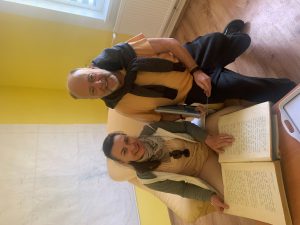
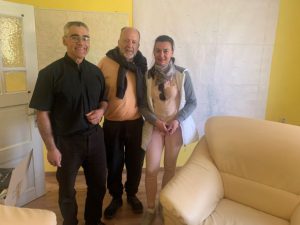
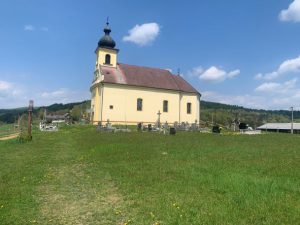
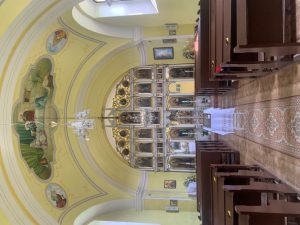
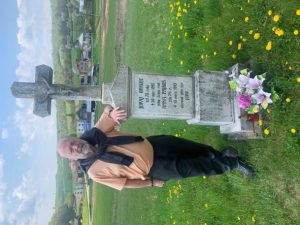
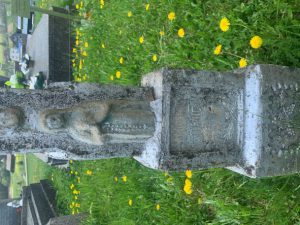

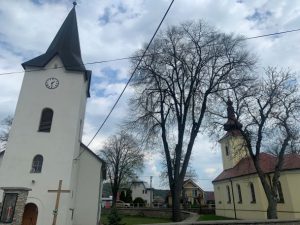
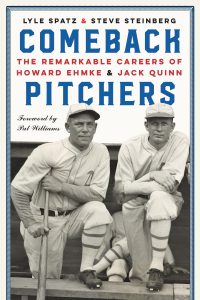
May 4, 2022
More on Kosice, More on Ukraine
I had no idea I’d be based in such a lovely city. First, the restaurants in Kosice are many and very good. Slavia (also Slavia Hotel) is a terrific upscale restaurant with a lovely bar, and Bistro Blanc is a casual restaurant that serves a changing menu each day. Kavy Sveta is one of countless coffee houses and one of the oldest. (Photos below.) One night I stopped at the oldest brewery in town, Golem Pub, and the story of the Golem in Jewish folklore is fascinating, esp. in the Czech and Slovak Republics.
https://www.nytimes.com/2009/05/11/world/europe/11golem.html
BTW, I post restaurant and hotel reviews on Trip Advisor under the name 1926yanks. I have now posted 272 reviews over the last few years.
I returned to the DSA Academy in the town of Trebisov and met the director, who doesn’t speak English, but likes baseball. (See photo.) He’s a fan of sports history and has made some US trips. We talked about the uncertainty of the war, and the school will continue to provide that vital housing as needed. I delivered some big boxes of Legos for the refugee kids the school is housing. Also funding for the therapy of a refugee youngster dealing with MS. During her almost 3 weeks in an underground bunker, she obviously did not get any treatment, which she can now resume. I’ve made another Metro Run to the Food Bank with Ali. When we arrived as the “store” was opening, the line was long and and am distributing the money that I’ve gathered to the local Rotary, while some of you have donated directly to Arnie Weiss’s GoFundMe site. Details are on the previous blog below.
I am excited that Ali and Arnie have connected, and the refugees will now have a medical care center they can turn to.
Jill Biden will be coming to Kosice this weekend, and Arnie is trying to get her to the Food Bank for publicity about the refugees (and a good Photo Opp for her). . . . An interior shot of the majestic cathedral, which towers over the center of the city. . . . An exterior shot of one of the many sidewalk cafes under the shadow of the Cathedral. . . . My college roommate from Jerusalem from many years ago is organizing “We Stand in Silence” protests in front of the Russian Embassies one hour a week and is trying to generate a groundswell at these embassies everywhere.
I want to give a Shout Out to a wonderful company here in Slovakia, whose Kosice team is providing vital support to the refugee children, so many of whom have experienced real trauma. Usmev ako Dar (which means “A Smile as a Gift”) is a company dedicated to psychological support for children. I sat down with one of the psychologists one morning to find out more about this respected and effective company that has been helping children for more than 30 years.
https://www.usmev.sk/wp-content/uploads/2020/04/About_Smile_as_a_Gift.pdf
The most moving reminder of the horrors of war and the power of love is this little video of a Ukraine nurse who lost her legs to a leg mine and dances in the hospital with her husband after their wedding ceremony.
https://www.youtube.com/watch?v=z2FdDAoTCpY
Finally, a popular Ukrainian song of hope and love, “Obyjmy” (“Hug Me”), “Hug Me and War Will Be Over . . .
https://www.youtube.com/watch?v=6hm0V49nsjw
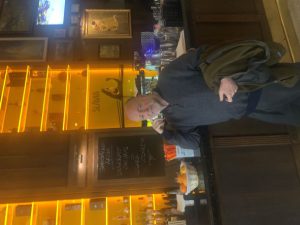
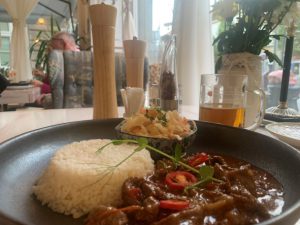

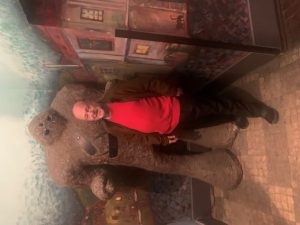
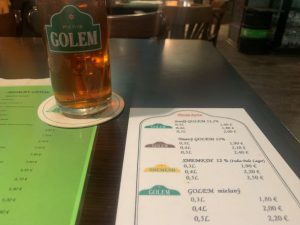
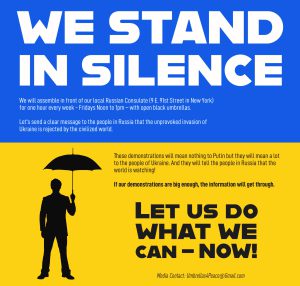
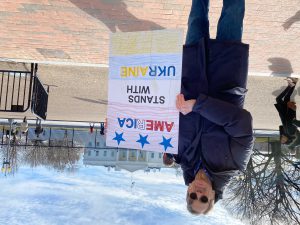
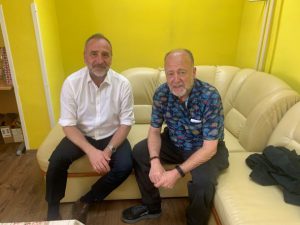
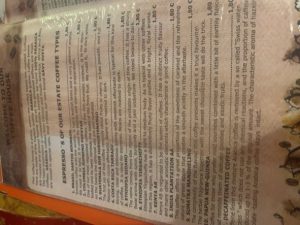
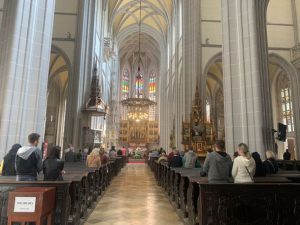
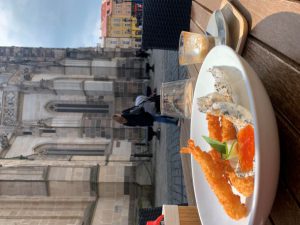
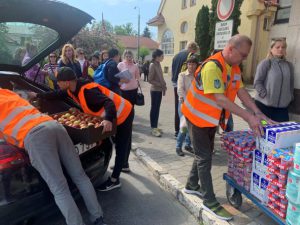
May 1, 2022
Ukraine Needs Our Help: Join Patron and Become a Patron of Ukraine
You may have heard about PATRON (pronounced pa TRONE’), the little Ukrainian Jack Russell terrier, who has been sniffing out mines in Ukraine that the Russians have left behind. He has gone viral and is even getting a stamp of his own (see below). You may have even seen a video clip of him in action:
Now I want to ask you to become a PATRON of Ukraine. As the war goes on, the need remains overwhelming, yet human nature is such that the urgency begins to drop as time goes on. We see it in something as basic as the decline in the number of daily donations to the Food Bank here in Kosice.
I have been here almost two weeks, trying to understand the rescue and refugee support efforts in Eastern Slovakia. There is much great work, though it is fragmented, with many companies and people involved. It also happens to be my birthday this Tuesday, and Facebook always suggests using it as an opportunity for the birthday person to designate his favorite charity. So if that gives you another reason to contribute, so be it.
There are many worthy groups here, and I want to suggest just two or three ways you can make a difference.
1. Arnie Weiss, an east coast (US) businessman, married to a lovely Ukrainian woman, Sylvia, and now living here, has been a tireless supporter, making regular runs out of his own pocket to the Metro (warehouse store) to replenish the SOS Food Bank for the few hundred refugee families here. I made three runs with him last week and will make a few more this week. All of the money you donate will go directly towards food and toiletries that the hundreds of refugee families in this area need, which Arnie will purchase. (See photos of Arnie and me below.) He has set up a GoFundMe account:
https://www.gofundme.com/f/direct-support-for-refugees-at-the-skua-border?utm_campaign=p_lico+share-sheet&utm_medium=copy_link&utm_source=customer
2. Rotary Club 2240 Kosice While Rotary International has been doing great work in support of Ukraine refugees (as well as those throughout the world), I want to get the money to the “front lines” as fast as possible. This is my decision. Unfortunately, right now, the local Kosice Rotary Club does not yet have a “DONATE” button that makes it easy to donate. So instead, I am going to make two suggestions:
A. Send a Bank Wire directly to the Rotary Club 2240 in Kosice. I am attaching the two-page letter from the head of the local Rotary Club. It is running trucks with tons of foods and medical supplies to the dozens of Rotary Clubs INSIDE UKRAINE.
Here is that Bank Wife info, which is also on the second page of the letter:
Official District 2240 bank account:
IBAN: SK03 1100 0000 0029 4112 4258
Bank account name: Rotary klub Košice
Bank account holder: Rotary klub Košice Classic
Hotel Slávia, Hlavná 63, 040 01 Košice, Slovakia
Bank SWIFT: TATRSKBX
Bank name: Tatra banka, a.s.
Bank address: Hodžovo námestie 3, 811 06 Bratislava 1
Country code: SK
B. If you find this wire transfer too cumbersome, I am accepting money into my PayPal account, which I’ve always used to pay for the baseball wire photos I collect and never to get money coming in. This was not my desired choice, but the situation is urgent. MOST OF THE MONEY YOU SEND TO ME IN THE NEXT 72 HOURS (until Wednesday night at midnight), I will get into Ukraine Rotary clubs. A portion of it will go to the Medical School students who are supplying the Emergency Shelter at the bus station (led by Ali Adel, who grew up in Baghdad during that war), where arriving refugees are received. Ali’s group is not set up to handle direct donations. (I will make a run with Ali to Metro tomorrow.)
Go to your PayPal account OR www.paypal.com
Click on SEND & REQUEST
Select Friends or Family, as opposed to buying Goods and Services (There is a small fee for “Friends and Family” if you use a credit card, as opposed to paying from a linked bank account.)
Enter my email address or phone # ssteinberg@trinorth.com 206 972 2048
Enter the AMOUNT of your donation
Review, Confirm the amount, and decide on your funding source-PayPal account, linked bank account, a credit or debit card
MOST OF THE MONEY I RECEIVE BY WED NIGHT US WILL GET INTO THE PROPER HANDS TO GET ACROSS THE BORDER TO ROTARY CLUBS IN UKRAINE. (A portion will go to the Medical school students, for the Rescue Center.) IT WILL GO ONLY FOR HUMANITARIAN NEEDS, AND NOT WEAPONS OF ANY KIND. I can assure you it will get to where it can make the most impact the quickest.
These donations may not be tax-deductible. Consult your tax advisor.
Finally, here are some photos of Ukrainian families I have been in contact with. I posted on Facebook that one way to combat Random Acts of Violence is with Random Acts of Kindness, like the Legos I’ve been buying for kids. (See photo) I’m delivering some Legos for “Ages 4-99” (see Lego boxes, photo) to a nearby village that is housing refugees. I had dinner with a dear friends (married to a Slovak fellow) Her mom and little brothers are refugees here. They call home each day, where dad has stayed behind to defend his country. (See photos) And today in a citywide celebration, my friend’s dance studio did some amazing performances. I met with a talented girl who had just escaped from Ukraine and fit right in. (see photos)
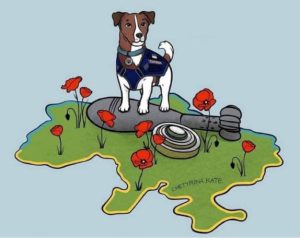
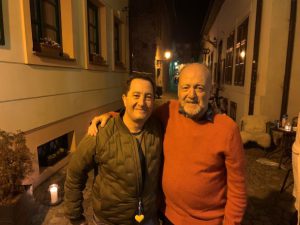
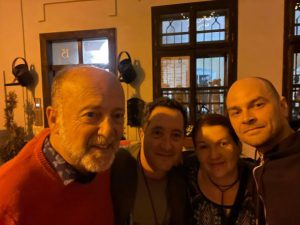
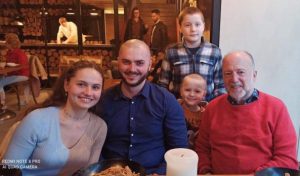
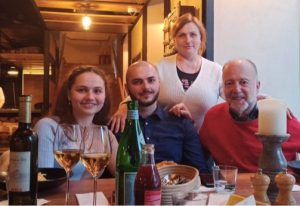
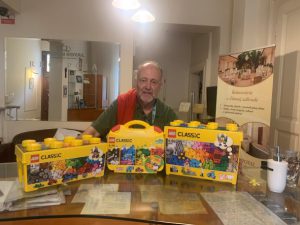
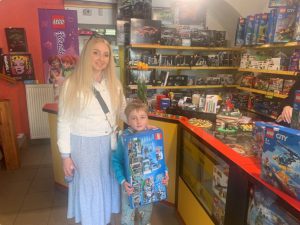

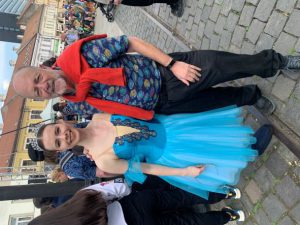
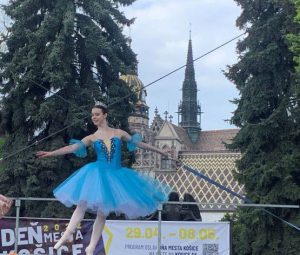
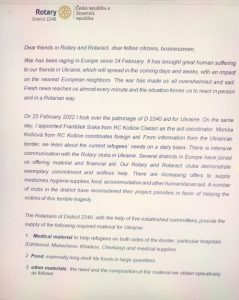
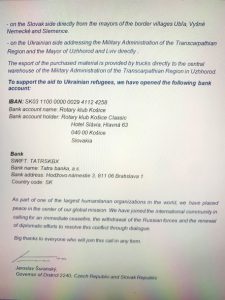
April 30, 2022
12 Days in Kosice
This blog will be an overview of Slovakia’s second largest city, photos taken over almost two weeks and unrelated to the crisis in Ukraine. It has been striking, as many of you have noted, how normal life seems to be not far from the devastation. I sometimes think I could be in a western European city, like Milan or Porto, with all the cafes, coffee shops, and carefree atmosphere. I think that below the surface, there may be more anxiety than is evident. People know what Russia is capable of, and perhaps a coping mechanism is to go on with life as normally as possible. I imagine many people may think, “There but the grace of God go I . . ”
I really did not expect anything special here. But I have been blown away by the charm and vitality of this city, Slovakia’s second largest. Bratislava is far to the west, 270 miles (440 km) away. Kosice has about 240,000 people, but the surrounding area has many more. Keep in mind there are only about 5 million people in this country. (Kyiv, the capital of Ukraine, hwa as many people as all of Slovakia.) There are young people everywhere, young couples, with and without kids, a medical school and technical school (both at university level), as well as a regular university. Prices (for food and lodging) are very reasonable, and this city should be more of a draw for tourists from outside the country. Business is slow now-partly because April’s weather can be mixed (after a number of days in the high 50s, it is now in the high 60s), and bpartly ecause of the war.
For those of you following me on Facebook, many of these are repeat images. But many of you are following me only here. These comments are for the images below, though I’m still not able to slot them in the order I want.
*The Ukrainian families are often noticeable because there is no male. Dad/husband is back home defending his country, and mom/wife is very worried and calls him daily. Many (most?) of the families have no more than two children. Where you occasionally see a male head of household with Ukrainians, it is when a Ukrainian girl has a Slovak husband. The dress of the little Ukrainian girl below is wonderful. She is unknowingly a fashion trendsetter.
*The State Theater sits opposite St. Elizabeth’s Cathedral. They dominate Hlavna Street,a pedestrian boulevard. It is a magnificent baroque building with a lovely interior. It seems big on the outside, but there are only ten rows (of about 20 seats each across), plus spectacular balconies. I saw Massenet’s opera, Werther, there. It played only one night and was quite good. The lead (Werther) was Peter Berger, a noted Slovak opera figure. To me at least, he towered over the female lead for Charlotte.
*Hlavna street has countless cafes and coffee shops. There are also many of both down side streets, which one photo shows.
*The Dog Shelter is about a 20-minute drive out of town. I expected to see many refugee dogs. But that was not the case because most places housing refugees have been willing to take pets. The shelter was impressive: 200-300 dogs (cats at another shelter I did not visit). They never kill a dog here and got me thinking that the phrase “no-kill shelter” is weird. If a place is a shelter, there should not be killings there . . . One of the dogs was the powerful Asian Shepherd Dog, known as the Alabay or Alabai (see photo). He guards livestock, can weight up to 170-180 lbs. and has a nickname of “Wolf Crusher.” My guides were a couple high school girls who hope to become veterinarians.
*There is a newer, more western part of town nearby, with a Doubltree Inn dominating the horizon. The AuPark Mall is a 10-minute walk from downtown. It is very modern, on three levels. There are two other malls, even larger, further from town. I discovered that Legos are indeed universal. As I commented on FB, I don’t know what the world will look like in 100 years, but people will still be playing with Legos.
*Before WWII, the city was about 25% Jewish. There are 3 synagogues in town. Here’s a photo of the largest; very impressive. But it is not open regularly for services or tours. Not sure why not the latter- they could generate some revenue. I was surprised to see Matzoh (not for Passover and called Maces) at the big Metro warehouse store. With the long history of the city’s Jewish population, the non-Jewish population was used to them, and such unleavened bread is still in demand (see photo).
*Photo of Skoda SUV. Skoda is a Czech company. The automotive industry is the largest in Slovakia. The country produces 1 million cars and is the highest producer of autos per capita in the world.
Finally, while donuts are trending in the US and rising in price, here you can get a little basket of mini-donuts for 3 Euro. And everywhere I go, lemonade is made with real fruit, often with seltzer water. Beers are plentiful, and Pilsner Urquell is on tap everywhere, as well as the local brews.
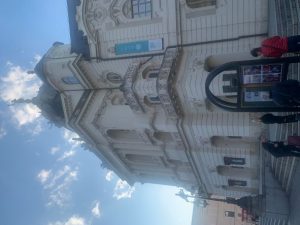
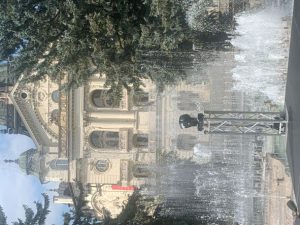
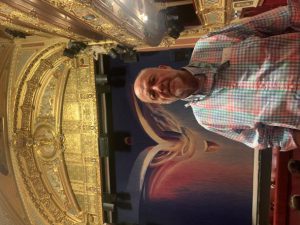
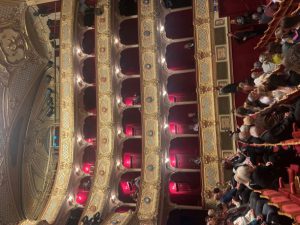
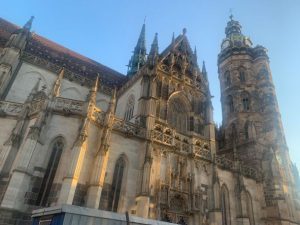
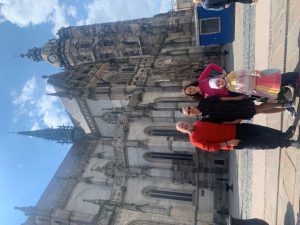
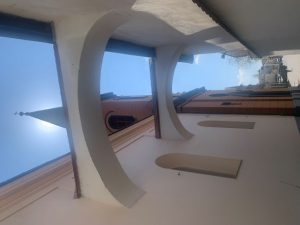
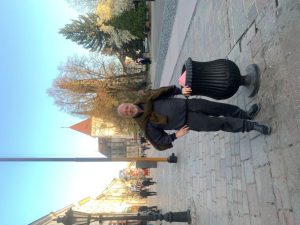
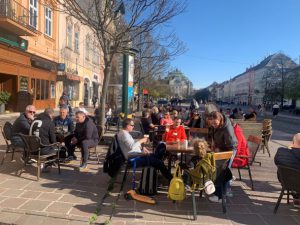
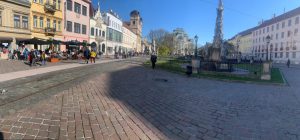
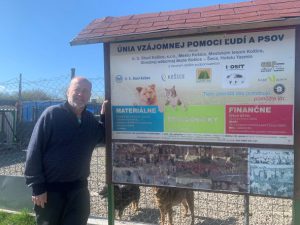
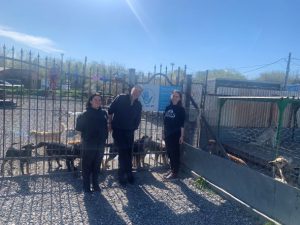
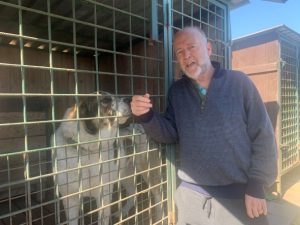
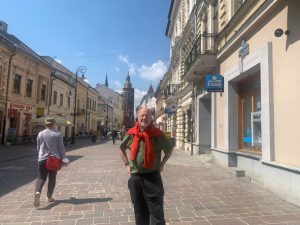
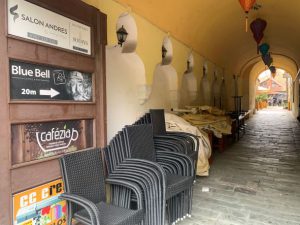
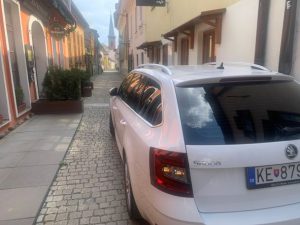
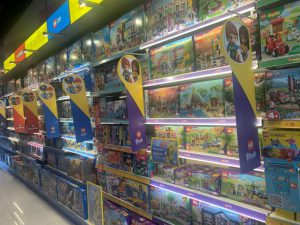
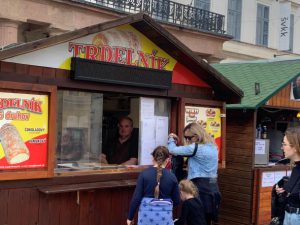
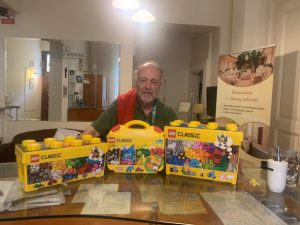
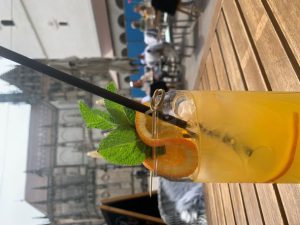
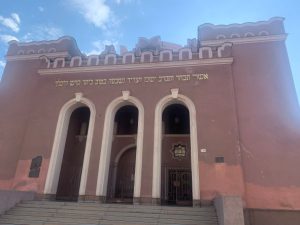
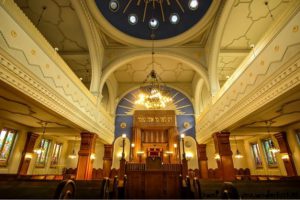
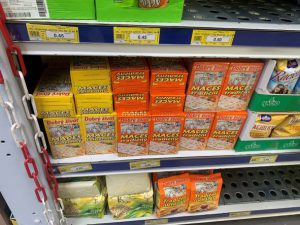
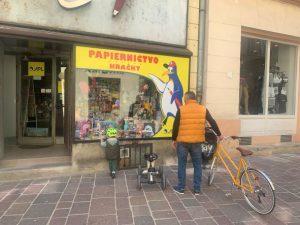
April 29, 2022
Stocking the Food Bank for Ukrainians
Many people in Slovakia are supporting the Ukrainians. Rotary Clubs are sending tons of food and supplies into Ukraine. Here in Kosice there is the need to supply the refugee families. Enter people like Ali Adel, the Iraqi medical student who helps the Emergency shelter at the train & bus stations. Also enter Arnie Weiss, a Yankee fan from Miami, who lives in Kosice with his Slovak wife. He is constantly supplying the SOS Center, the Food Bank for refugee families. I joined him to to METRO, a huge wholesale club (like Costco, but even bigger), on the outskirts of town.
As is often the case, the SOS Center was almost out of food. We made three runs, and my money went far with these prices. The first run was for food such as rice, beans, oatmeal, and nutritious snacks. Arnie is the expert on what items “go the farthest” and what is needed the most. When I suggested pasta, he said it was not needed because skier Mikaela Shiffrin’s foundation is supplying it. We also bought flour and cooking oil but were limited to 5 cases of each (each case had ten packs or bottles). Why? Ukraine produces so much of the world’s wheat and sunflower oil, and the war has created a world-wide shortage. [Since we made three trips to Metro, we were able to buy 15 cases of each!]
An ironic sports aside: While Mikaela Shiffrin (pic in Barilla cap) suffered bitter disappointment at the recent Olympics, Slovakian skier Petra Vihova (pic in knit cap) just won the Gold Medal in Slalom. A first for the nation in Alpine skiing.
Another aside: With the mask requirement lifted last week, virtually no one here is wearing a mask. You’ll note the Metro cashier was, but she was literally one in a thousand (thousands?) While most people here have been vaccinated, that is not the case with the Ukrainian refugees. Even when offered, many don’t want or trust it. Of course, survival is utmost on their minds.
Our second trip was for just three items: huge sacks of potatoes (25 kg ea), onions, and carrots. Each time, we ran back to the SOS center, where we quickly unloaded with the help of the Ukrainian volunteers (even some older, like me). Other volunteers then broke the packages and bags into smaller units (a bag might have 10-12 potatoes). Laura (pic with me) oversees the center.
With a few hundred refugee families, the SOS Center needs constant replenishment. Arnie is constantly doing so; I just picked up the tabs one day. With my stenosis, Arnie called me “Good heart, bad back.” In reality, my heart is not in great shape either . . . But both are under control. I realize I did not take a photo of us together . . .
A fact of human nature may be that as a crisis goes on for a while (and this one may go on for quite a while), people tend to lose the sense of urgency that they have at the start. Drop-off donations have dwindled. But the need remains. Most of the refugee families here have found housing, but their budgets are impossibly tight. A few hundred families visit the SOS Center each day.And let’s not forget that “family” means a mom with her child/children, and possibly also her own mom. Dad is back in Ukraine, />defending his country.

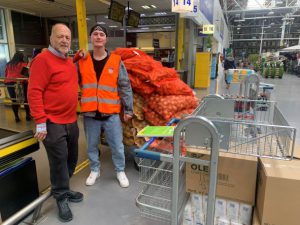
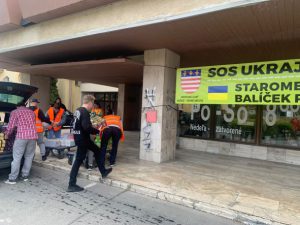
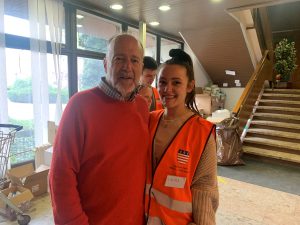
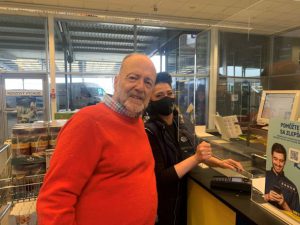
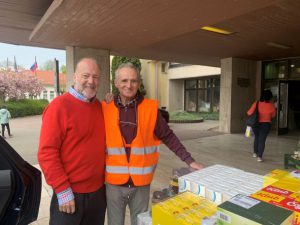
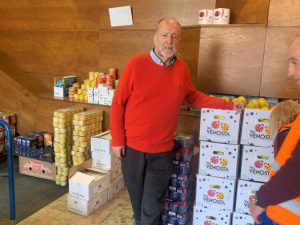
Finally, the SOS Center is in the main level of the Municipal Building. The President of Slovakia, the very popular Zuzana Caputova, was visiting on this day, and greeting the President of Germany. So security was tight!
April 27, 2022
School Visit, Trebisov
Imagine you are awakened at night by a loudspeaker announcing your area is about to come under attack. You have 30 minutes to evacuate. You can bring along one bag (BAG, not suitcase) with you. What would you take?
Imagine you have been hiding with your child in a bunker for 17 days. Suddenly you hear that a car will make a run for the Slovak border, and there are two extra seats. You grab your child and squeeze in. You are not sure if you will survive the trip, but the alternative in the bunker is not promising.
These are just two experiences of families I have met.
Trebisov is a Slovak town east of Kosice, about 30 miles (45-50 km) from the Ukraine border. I am constantly asking, “How can I help? Who needs support?” I had heard about a school here that is housing some Ukrainian refugees here. I made the hour-long train trip (about 5 Euro RT). DSA is a German-Slovak Academy with schools in both countries. This school has a vocational high school, as well as a kindergarten. Some students stay in the dorms; others commute each day. Even before the war, there were a few Ukrainian student here, learning a skill.
The school is impressive for a few reasons. It took over an older, abandoned school building and gave it “life.” The skills it teaches are modern skills, inc. the fields of mechanical engineering, water supply, and mechatronics (a new word and field for me). The school still wants the students to be well-rounded. So (as you can see from the photos below), gym/athletics is a required course, music is offered, as are social sciences. My guide was a history teacher, who gave me the opportunity to speak to his class. Another specialty is teaching youngsters, and the kindergarten provides real-life, hands-on experience.
The school is not set up for accepting donations, and I will return to help buy food supplies. The school provides free housing and meals to the refugees, some of whom I met. (The man in the photo is Lukasm my guide and the school’s history teacher.) The rooms are small, but at least the people have a place to rest and feel safe. As one photo shows, I interrupted a birthday party of a little boy, the youngest in the photo.
I SEE HOPE IN THEIR EYES, THE FUTURE GENERATION OF UKRAINE.
https://www.dsakademien.sk/about-dsa/#
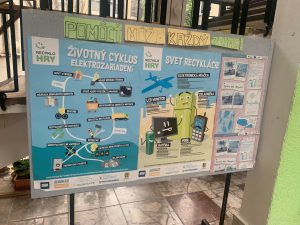
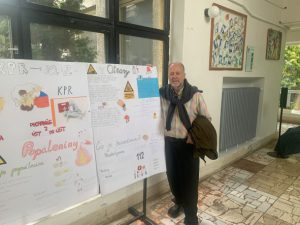
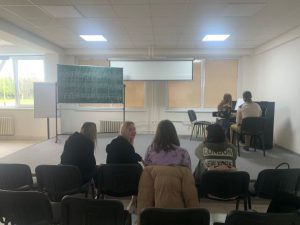
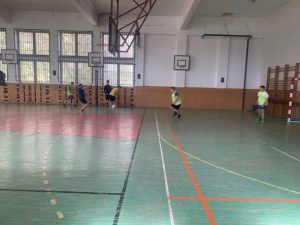
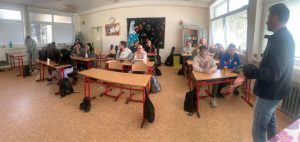
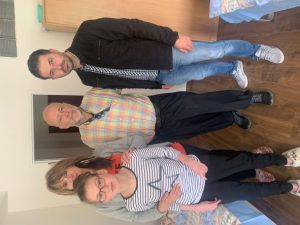
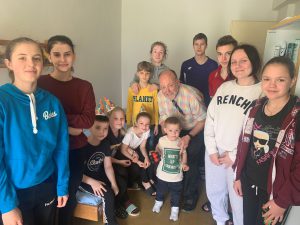
April 26, 2022
Easter for Ukraine
On Easter Sunday in Kosice, a major volunteer effort made the holiday very special for the Ukrainian refugee families, especially the children. The event was a major organizing effort, and once again Ali (photo with me) and his fellow Medical students at the university in Kosice, did so much work. I merely helped with a few tasks, inc. not-so-critical job of placing 3 Easter eggs in each basket, along with the sausages, ham, and muffins.
As I posted on Facebook, “Have you ever been overcome by emotion at an event where you didn’t know what was being said? Now I have, Because I really DID KNOW.” The solemnity of the occasion was marked by prayers and blessings from the Eastern Orthodox religious leaders.
So many people wanted the Ukrainian flag painted on their cheeks, adults included. You can guess which two colors of paint ran out, requiring Ali to go to the store to buy more.
Finally, the story of Yana (seen with me as I munch on Ukrainian Easter cake) is just one of many. She lives (lived) in Irpin, just 3 miles (5 km) south of Bucha, where the atrocities were perpetrated. While she is safe, he home was not saved, hit by a missile.
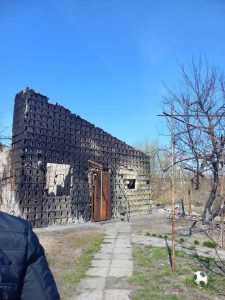
Most of all, at least for one afternoon, the children did what children should do on a holiday: Forget their worries and have fun. When happiness is in short supply, it is remarkable how far a little kindness goes.
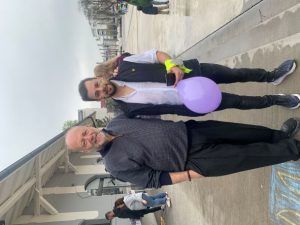
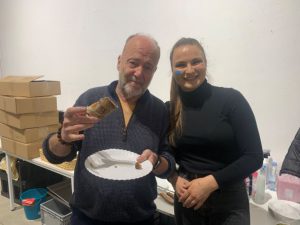
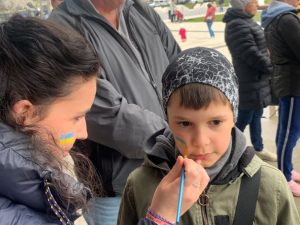
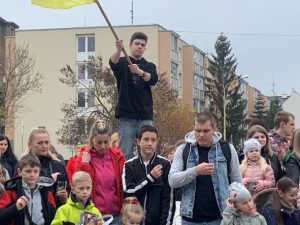
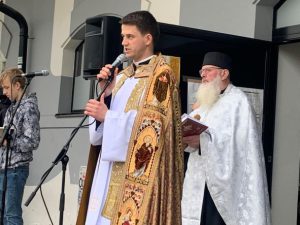

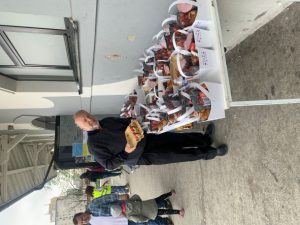
April 24, 2022
On the Ground in Kosice
In my first few days here, I am getting the lay of the land, contacting many people to see how I can best help and where the money can do the most good. I’m realizing that part of the “Overwhelmingness” I referred to in yesterday’s blog is navigating the language barriers and various people and groups. Some people here speak some English (more in hotels & restaurants; less in the general population). Part of the “Overwhelmingness” is the fragmentation of relief efforts. Many groups and individuals are doing great work. The Evil of this war has generated an amazing response of Good.
Far fewer of the refugees speak English, and when they text it’s in the Cyrillic alphabet. So I get a simple message, such as: “Дякую вам дуже !! Гарного Вам дня !” It means, “Thank you very much!! Have a nice day!” Thank God for Google Translate! If I “Friend” a refugee on Facebook, I know how to say her name, but I can’t type, it in to find her in Messenger. I can say, for example, “Myroslava,” but I have to paste in “Мирослава.” BTW, a typical refugee “family” is a mom with 1-2 kids, and often the mom’s mom.
I first met with four leaders of the local Rotary Club #2240, which is coordinating a massive resupply of goods from Rotary Clubs in Europe to the Rotary Clubs throughout Ukraine. This is an effort on an enormous scale, with vans and trucks. Slovak companies (like others throughout Europe) are supplying the Rotary with reduced-price goods. More than 20,000 Euros went to the purchase of an ambulance, for example. (See photo)
I visited the Refugee Center my second day. It is right next to the bus and train stations. Until now, if I hear the word “Container” next to the word “human,” the connotation is bad (i.e., human trafficking). But here the containers are so important: They provide the housing for the refugees. Very basic, but a place to lie down and rest. (See photos) Mothers with babies have more room. “Port-a-potties” (portable bathrooms) are nearby. There are showers too. Right now the number of people coming thru is not huge. Many stay for only a night or two, then going on further west. Michaela and her volunteer staff are amazing. I was talking to a woman who came over from Prague to volunteer. And there is a group of students from Spain who are here for a few weeks.
I made some “shopping runs” to buy groceries for the communal kitchen and toiletries for a number of refugee kids. I was helped by Felix, a student from the medical school here in Kosice. Some of those students, led by Ali (orig from Baghdad, who knows war and what it’s like to be a refugee) have been doing this on a regular basis. When I first visited the refugee center, I didn’t realize this was where Ali had filmed his great video (see below), which I saw before I got here.
Some of the refugees stay in the area, and that’s where volunteer host families step up. Many take in not only the families, but their pets too! That’s why I saw so few refugee dogs when I visited the dog shelter outside of town!
I will soon post my suggestions on how you can donate and support the massive and desperately-needed efforts for Ukraine. Check out my last photo below of the lovely armed guard, one of the municipal police protecting the refugee center.
Take a few moments to watch Ali’s video with Michaela at the refugee center.
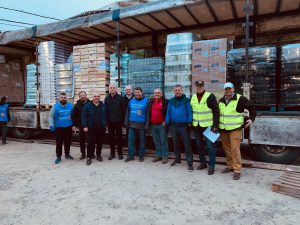
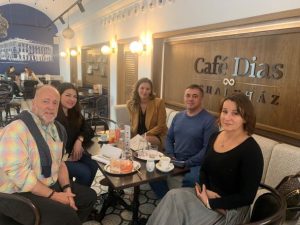
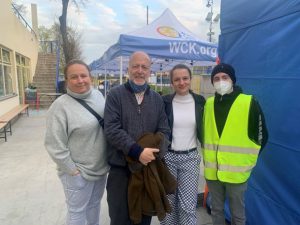
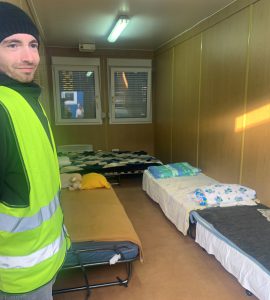
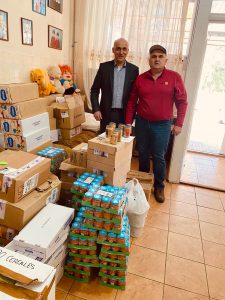
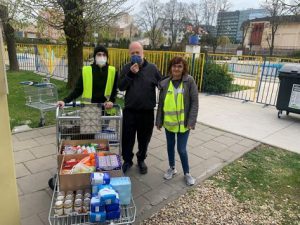
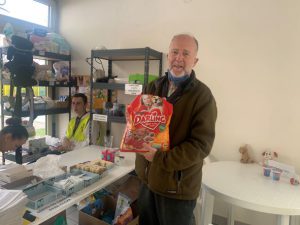
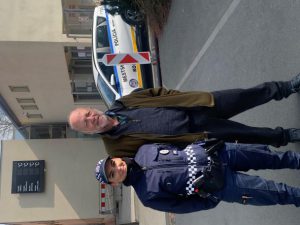
April 22, 2022
Overwhelmingness
Overwhelmingness. I’m a writer, and I know this is not a word. But I made it up, to convey the sense of what I see and hear and know is going on. The devastation of the invasion of Ukraine is so enormous, as are the death and suffering it generates. The confusing mixture of feelings and emotions I have, from anger to frustration to helplessness.
The change in perspective that happens overnight. The young woman who arrives to the Refugee Camp in Kosice with her son and mother. A few weeks ago she was wondering whether she would buy a red or a yellow dress for summer. Now she is dealing with survival and is wonders where she will go next, whether her son would ever see his father–who had stayed behind to find for his country–again. I recall reading that when poet Walt Whitman was young, he cared for Civil War victims, many of whom had lost limbs. He wrote his mother something to the effect of “Nothing WE call ‘trouble’ seems worth talking about.”
Kosice, Slovakia is the nation’s second biggest city, with about 240,000 people (see photo at dusk). The entire country has only 5 million people, compared to 38 million in Poland.) It is a vibrant, urbane, attractive city. So many young people. A hip bar scene. (There’s a Pilsner Urquell Pub and a Cigar Bar.) Just 60 miles (96 km) from the Ukraine border, it is a key transit location: of refugees heading ,to other points in Europe, and of goods heading east, into Ukraine, from food and water to medical supplies. So many dedicated people are doing good, over and above their busy regular lives. little steps that make a difference.
I think of the story of the little boy and the starfish, which made a real impression when I heard it. It seems so fitting today. I attach a copy of it below. (There are slightly different versions.) I also came across a powerful video that a Ukrainian Facebook Friend had posted. Take three minutes to watch it. In my next blog, to follow soon, I will be more specific in what I’m finding and doing, also just one “starfish at a time.” I’m including a map of Slovakia again, so you can find Kosice on the right/east side of the country.
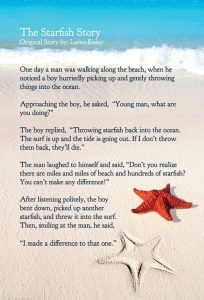
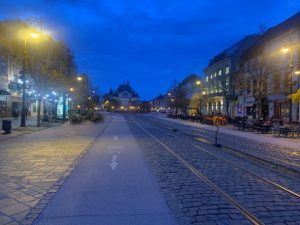
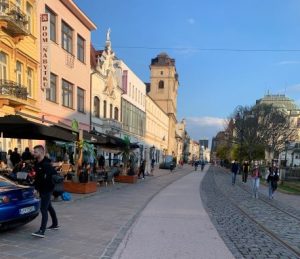
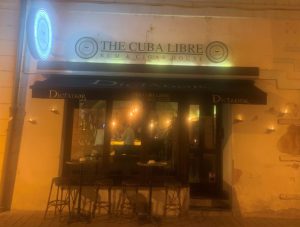
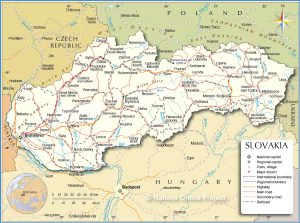
April 19, 2022
Revisiting the Holocaust before Encountering the Ukraine Crisis
Yesterday I visited Budapest’s Dohany Street Synagogue, the largest in Europe. It is a grand design, reminiscent a bit of a European opera house, with the multi-tiered balconies on each side. It is in the midst of what was the Budapest (Jewish) Ghetto of WWII. When the city was liberated from the Nazis (by the Soviet armed forces) there were many dead bodies still on the streets. They were quickly buried on the grounds of the synagogue. They remain a monument to the cruelty man is capable of.
There is also a metallic Tree of Life on the grounds, with more than 10,000 metal “petals,” each inscribed with the name of a Holocaust victim (only a small fraction of the Hungarian Jews who perished). Actor Tony Curtis (father of Jamie Lee) was a driving force in that project. His parents were emigrants from Austria and Slovakia. (His mother was born in a Slovak village not far from Kosice, where I will be.)
There are also reminders of the good man is capable of. The garden is dedicated to Raoul Wallenberg, the Swedish diplomat, and other “Righteous Gentiles,” who helped save many Jews from deportation. Each of the names on the plaque has a remarkable story of bravery and heroism. I suggest you pick just one, google him and learn his story.
The train into Kosice is about 3.5 hours (from Budapest). I will be meeting with the local Rotary chapter tomorrow. It has been on the cutting edge of refugee relief efforts, both helping those who have reached their city and supplying provisions across the border to western Ukraine.
I met a Ukrainian girl on the train, in her final year of medical school in Uzhhorod, the Ukrainian city on the border with Slovakia (and sister city of Corvallis, OR, though she tells me they call it “brother city”). It is less than an hour from Kosice. She has been studying for Finals. But with the sirens constantly going off, studying in the bomb shelters was difficult. So she visited relatives in Hungary and got her studying done there. Now she is going back to Ukraine.
